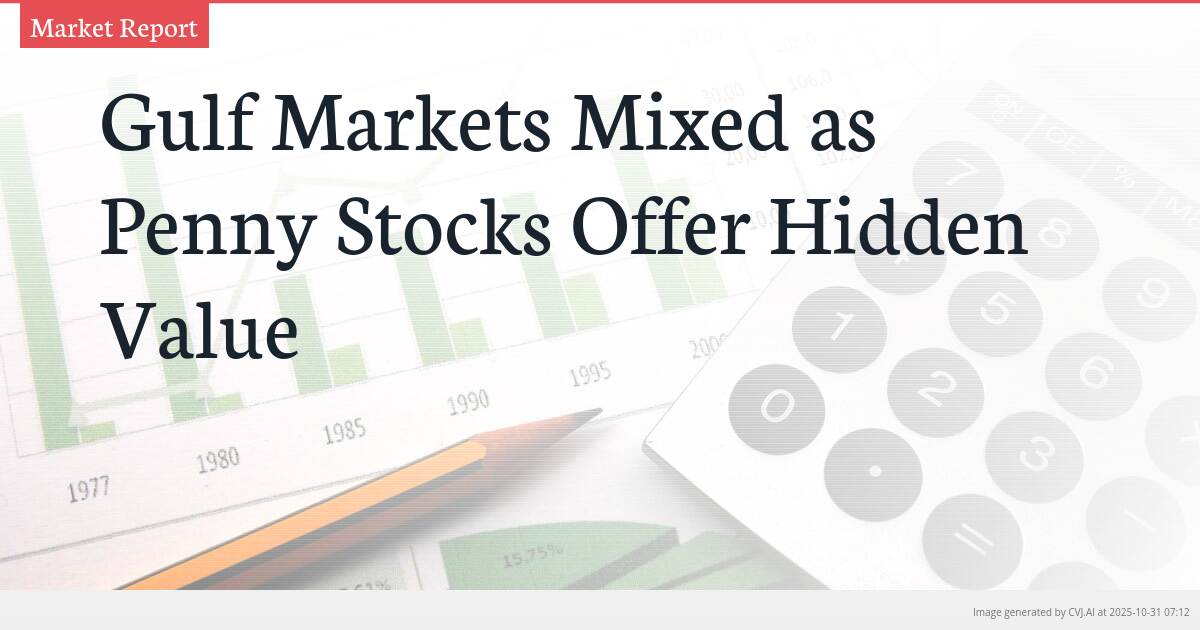This summary text is fully AI-generated and may therefore contain errors or be incomplete.
Introduction
Middle Eastern stock markets delivered a mixed performance this week, with most Gulf markets climbing on positive earnings and Fed rate cuts while Saudi Arabia’s index declined. Meanwhile, penny stocks continue to present intriguing opportunities for investors seeking value in smaller companies. These overlooked assets can deliver surprising returns when backed by strong financial fundamentals.
Key Points
- Most Gulf markets rose driven by positive corporate earnings and U.S. Federal Reserve interest rate cuts
- Saudi Arabia's stock index declined despite broader regional gains, showing market divergence
- Penny stocks represent overlooked investment opportunities when supported by strong financial health indicators
Divergent Trends Across Gulf Markets
Recent trading sessions revealed a clear divergence in Middle Eastern stock market performance, with most Gulf exchanges advancing while Saudi Arabia’s market bucked the trend with notable declines. The broader regional gains were primarily driven by two key factors: stronger-than-expected corporate earnings reports and supportive monetary policy from the U.S. Federal Reserve. This combination created favorable conditions for equity investments across most Gulf Cooperation Council markets, though the Saudi market demonstrated its unique characteristics and sensitivities.
The positive momentum in Gulf markets reflects the interconnected nature of global financial systems, where U.S. monetary policy decisions continue to exert significant influence on Middle Eastern exchanges. Federal Reserve rate cuts typically reduce borrowing costs and improve liquidity conditions, making equity investments more attractive to both domestic and international investors. This dynamic was particularly evident in markets with strong corporate earnings, where companies demonstrated resilience and growth potential despite broader economic uncertainties.
Saudi Arabia's Market Stands Apart
While most Gulf markets experienced gains, Saudi Arabia’s stock index moved in the opposite direction, highlighting the distinct factors influencing the region’s largest economy. The decline in Saudi Arabia’s market occurred despite the broader regional uptrend, suggesting country-specific considerations may be outweighing the positive effects of Federal Reserve policy and corporate earnings strength seen elsewhere in the Gulf.
This divergence underscores the importance of analyzing individual market dynamics rather than treating Middle Eastern exchanges as a monolithic bloc. Saudi Arabia’s market, being the largest and most influential in the region, often responds to unique domestic factors including oil price movements, government policy changes, and sector-specific developments that may not affect neighboring markets to the same degree. The current underperformance relative to other Gulf markets presents both challenges and potential opportunities for investors focused on regional allocations.
The Enduring Appeal of Penny Stocks
Beyond the mainstream market movements, penny stocks continue to represent overlooked investment opportunities when supported by strong financial health indicators. Despite their outdated reputation for high risk and volatility, these smaller company stocks can offer surprising value for investors willing to conduct thorough due diligence. The key differentiator lies in identifying penny stocks with solid financial fundamentals rather than speculative narratives.
When these micro-cap investments are backed by healthy balance sheets, sustainable business models, and clear growth trajectories, they present a unique combination of accessibility and potential returns that larger, more established companies often cannot match. The current market environment, with its mixed regional performance and evolving monetary policy landscape, may create particularly favorable conditions for identifying undervalued penny stocks that have been overlooked amid broader market movements.
The analysis of penny stocks requires a different approach than traditional equity analysis, focusing on metrics that might be less relevant for larger companies. Factors such as cash flow sustainability, management quality, and market positioning become critically important when evaluating these smaller enterprises. For investors who master this specialized analysis, penny stocks can serve as valuable portfolio diversifiers and sources of alpha in a region experiencing divergent market performance.
📎 Read the original article on yahoo.com

